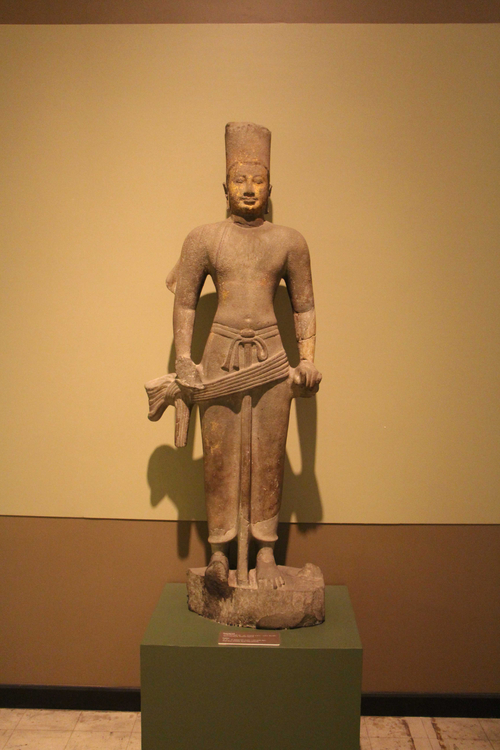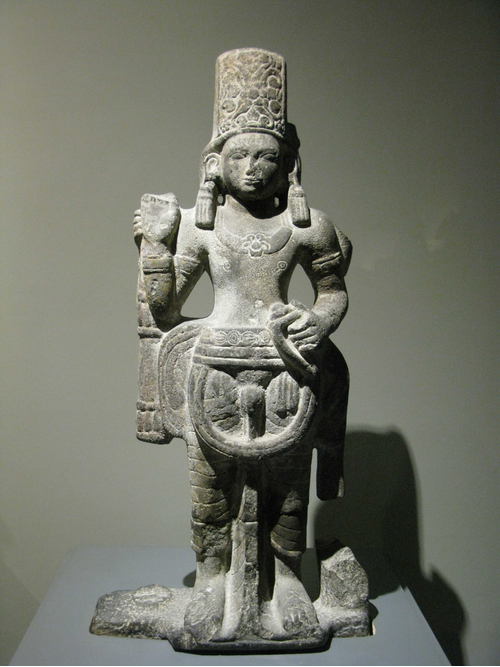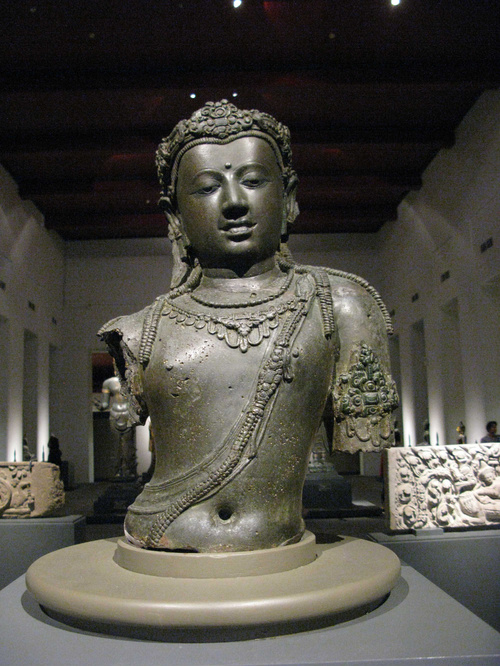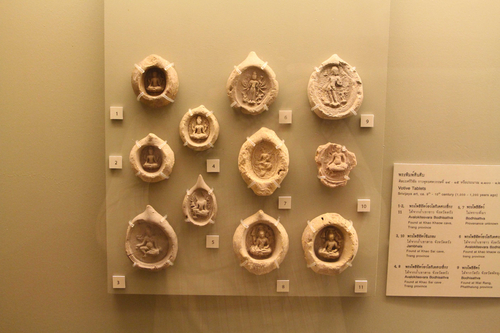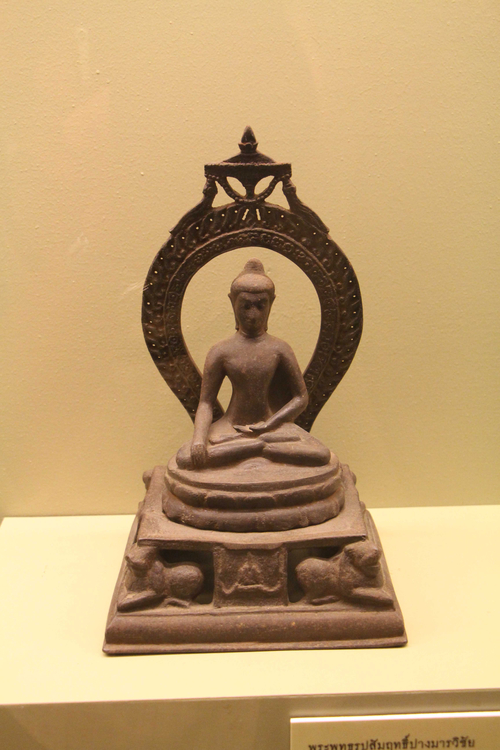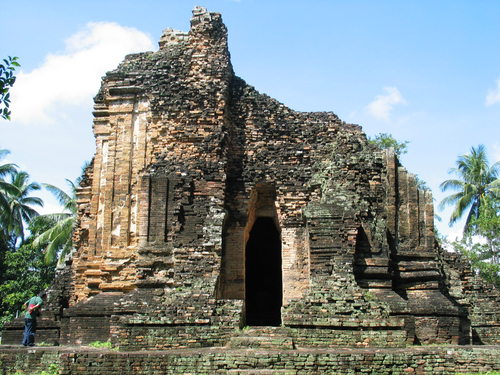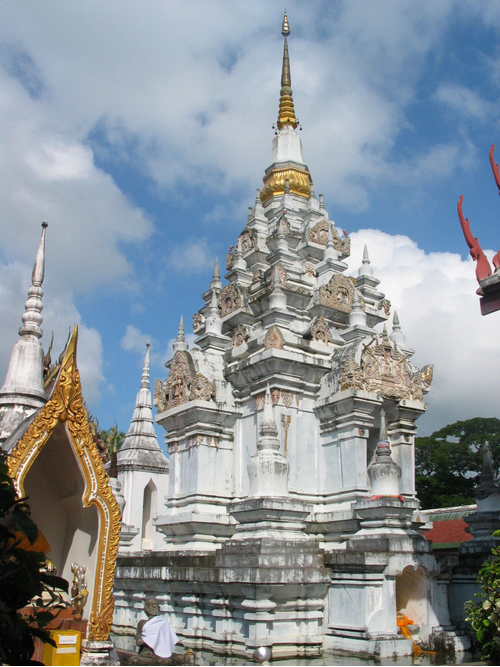ค้นหางานศิลปกรรม
ฐานข้อมูลศิลปกรรมในเอเชียตะวันออกเฉียงใต้
ประติมากรรมพระวิษณุ
พระวิษณุอยู่ในอิริยาบถยืนตรงบนฐานหน้ากระดาน สวมมงกุฎทรงกระบอกหรือกิรีฏมกุฏเกลี้ยง ซึ่งเป็นลักษณะสำคัญที่เห็นได้ชัดของพระวิษณุรุ่นแรกๆ ในดินแดนไทย สัมพันธ์กับพระวิษณุในศิลปะอินเดียแบบปัลลวะพระองค์มี 4 พระกร พระกรขวาหน้าทอดลงจรดพระโสณี (สะโพก) เชื่อว่าเดิมทีเชื่อว่าเคยถือสัญลักษณ์ก้อนดินไว้ในพระหัตถ์ แต่ปัจจุบันชำรุดไปแล้ว พระกรซ้ายหน้าทอดลงจรดพระโสณีและถือตะบองไว้ในพระหัตถ์ แต่ปัจจุบันตะบองชำรุดไปแล้วเหลือแต่เพียงส่วนปลายที่ติดกับฐานหน้ากระดานและโคนที่ติดกับพระหัตถ์ พระกรขวาหลังและพระกรซ้ายหลังหักหายไปหมดแล้ว เมื่อเทียบกับประติมากรรมพระวิษณุอื่นๆ เชื่อว่าทั้ง 2 ข้างยกขึ้น ข้างขวาถือจักร ข้างซ้ายถือสังข์ การถือสิ่งของทั้ง 4 ชนิดในตำแหน่งพระหัตถ์ข้างต้นนี้เป็นแบบแผนของศิลปะอินเดียแบบปัลลวะ พระวรกายช่วงบนเปล่าเปลือย ช่วงล่างสวมผ้านุ่งยาวหรือที่เรียกว่า “โธตี” มีผ้าภูษาคาดพระโสณี (สะโพก) เป็นแนวตรง ประติมากรผู้สลักพระวิษณุองค์นี้คงมีกังวลว่าจะชำรุดแตกหักได้ง่าย พระกรปกติทั้ง 2 ข้างจึงเชื่อมติดกับพระโสณี (สะโพก) และยังใช้จุดรับน้ำหนัก 5 จุด ได้แก่ พระบาท 2 ข้าง แถบหน้านางอยู่ตรงกลาง ชายผ้าภูษาพันรอบพระโสณี (สะโพก) อยู่ทางขวา และตะบองอยู่ทางซ้าย
ประติมากรรมพระวิษณุ
พระวิษณุอยู่ในอิริยาบถยืนตรงบนฐานหน้ากระดาน สวมมงกุฎทรงกระบอกหรือกิรีฏมกุฏเกลี้ยง ซึ่งเป็นลักษณะสำคัญที่เห็นได้ชัดของพระวิษณุรุ่นแรกๆ ในดินแดนไทย ทั้งสัมพันธ์กับพระวิษณุในศิลปะอินเดียแบบปัลลวะพระองค์มี 4 พระกร พระกรขวาหน้าทอดลงจรดผ้าภูษาคาดพระโสณี เชื่อว่าเดิมทีเชื่อว่าเคยถือสัญลักษณ์ก้อนดินไว้ในพระหัตถ์ แต่ปัจจุบันชำรุดไปแล้ว พระกรซ้ายหน้าทอดลงและถือตะบองไว้ในพระหัตถ์ แต่ปัจจุบันตะบองชำรุดไปแล้วเหลือแต่เพียงส่วนปลายที่ติดกับฐานหน้ากระดานและโคนที่ติดกับพระหัตถ์ พระกรขวาหลังและพระกรซ้ายหลังหักหายไปหมดแล้ว เมื่อเทียบกับประติมากรรมพระวิษณุอื่นๆ เชื่อว่าทั้ง 2 ข้างยกขึ้น ข้างขวาถือจักร ข้างซ้ายถือสังข์ การถือสิ่งของทั้ง 4 ชนิดในตำแหน่งพระหัตถ์ข้างต้นนี้เป็นแบบแผนของศิลปะอินเดียแบบปัลลวะ พระวรกายช่วงบนเปล่าเปลือย ช่วงล่างสวมผ้านุ่งยาวหรือที่เรียกว่า “โธตี” มีผ้าภูษาคาดพระโสณี (สะโพก) เป็นแนวเฉียงประติมากรผู้สลักพระวิษณุองค์นี้คงมีกังวลว่าจะชำรุดแตกหักได้ง่าย พระกรปกติข้างหนึ่งจึงยึดติดกับชายผ้าคาดพระโสณี และอีกข้างหนึ่งจึงยึดติดกับตะบองซึ่งเชื่อมต่อกับพระโสณีและฐานอีกทอดหนึ่ง นอกจากนี้แถบหน้านางที่พาดผ่านตรงกลางผ้านุ่งแทนที่จะมีส่วนปลายสิ้นสุดเพียงตำแหน่งชายผ้านุ่ง แต่กลับตั้งใจให้ยาวจรดฐาน ทำให้พระวิษณุองค์นี้มีจุดรับน้ำหนัก 4 จุด ได้แก่ พระบาท 2 ข้าง แถบหน้านาง และตะบอง
ประติมากรรมพระวิษณุ
พระวิษณุองค์นี้อยู่ในอิริยาบถยืนตรง สวมมงกุฎทรงกระบอกหรือกิรีฏมกุฏ ซึ่งเป็นลักษณะสำคัญที่เห็นได้ชัดของพระวิษณุรุ่นแรกๆ ในดินแดนไทยพระองค์มี 4 พระกรตามแบบแผนทางประติมานวิทยาของพระวิษณุ พระกรขวาหน้าแสดงปางประทานอภัย พระหัตถ์ขวาหลังถือตะบอง พระหัตถ์ซ้ายหน้าถือสังข์ในระดับพระโสณี (สะโพก) พระหัตถ์ซ้ายหลังหักหายซึ่งแต่เดิมควรถือจักร ท่าทางและการถือสิ่งของในตำแหน่งข้างต้นนี้มีมาก่อนแล้วในรูปพระวิษณุในศิลปะอินเดียภาคเหนือรุ่นก่อนพุทธศตวรรษที่ 10 พระวรกายช่วงบนเปล่าเปลือย ช่วงล่างสวมผ้านุ่งยาวหรือที่เรียกว่า “โธตี” บางแนบพระวรกายจนเห็นสรีระภายใน มีชายผ้าคาดพระโสณี (สะโพก) รูปวงโค้งพาดผ่านเหนือพระอุรุ (ต้นขา) ลักษณะเช่นนี้เทียบได้กับศิลปะอินเดียภาคใต้ในช่วงก่อนพุทธศตวรรษที่ 10
ประติมากรรมพระโพธิสัตว์อวโลกิเตศวร
ประติมากรรมนี้อยู่ในสภาพชำรุด เหลือเพียงพระเศียรและพระวรกายส่วนบนที่แสดงอาการเอียงตนหรือตริภังค์ ในขณะที่มวยพระเกศา พระกรทั้งสองข้าง และพระวรกายส่วนล่างชำรุดสูญหายไปแล้วพระพักตร์อวบอิ่ม เครื่องประกอบพระพักตร์งามสมส่วน เปลือกพระเนตรปิดลงครึ่งหนึ่ง มีพระอุณาโลมที่พระนลาฏ สวมมงกุฎที่ประดับด้วยกลุ่มเพชรพลอยทรงสามเหลี่ยม มวยพระเกศาที่เคยมีอยู่ทางด้านบนได้หักหายไปแล้ว เหลือแต่พระเกศาเป็นลอนสยายปะพระอังสา สวมเครื่องประดับจำนวนมาก ได้แก่ ยัชโญปวีตแบบหนังสัตว์โดยสังเกตได้จากหัวเลียงผาที่อยู่บริเวณพระอังสาซ้าย ยัชโญปวีตนี้ซ้อนทับโดยสังวาลไข่มุกประดับเพชรพลอยอีกชั้นหนึ่ง กรองศอมี 2 เส้น เส้นบนเป็นดั่งเม็ดไข่มุก เส้นล่างเป็นดั่งเครื่องประดับลายเพชรพลอยที่มีสายอุบะห้อยระย้า มีพาหุรัดประดับลายเพชรพลอย ในภาพรวมพระโพธิสัตว์องค์นี้แสดงความเกี่ยวข้องกับศิลปะอินเดียแบบปาละและศิลปะชวาภาคกลางของอินโดนีเซีย อย่างไรก็ตาม งานวิจัยของ รองศาสตราจารย์ ดร.เชษฐ์ ติงสัญชลี ชี้ให้เห็นถึงรายละเอียดที่ไม่ปรากฏทั้งในศิลปะปาละและศิลปะชวาภาคกลาง ซึ่งอาจหมายความว่าหล่อขึ้นในภาคใต้ของไทยเอง ได้แก่ ยัชโญปวีตแบบหนังสัตว์ที่ซ้อนทับด้วยสังวาลเพชรพลอย
ประติมากรรมพระพิมพ์
พระพิมพ์ดินดิบเหล่านี้ค้นพบจากหลากพื้นที่ในบริเวณภาคใต้ของไทย มีลักษณะเป็นก้อนกลม ส่วนบนยื่นแหลมเล็กน้อย บางองค์อาจทำส่วนล่างยื่นแหลมด้วย ประทับรูปพระโพธิสัตว์ หรือทิพยบุคคลอื่นๆ ไว้ตรงกลาง เช่น พระโพธิสัตว์อวโลกิเตศวร 21 กร พระโพธิสัตว์อวโลกิเตศวร 4 กร ท้าวกุเวรหรือท้าวชัมภละ พระพิมพ์แบบนี้ได้ค้บพบอยู่ตามดินแดนที่นับถือพุทธศาสนามหายาน โดยเพาะอย่างยิ่งราชวงศ์ปาละในประเทศอินเดีย และราชวงศ์ไศเลนทร์ในเกาะชวาประเทศอินโดนีเซีย เป็นหลักฐานแสดงความสัมพันธ์ระหว่างกันผ่านเครือข่ายการนับถือพุทธศาสนามหายาน
ประติมากรรมพระพุทธรูปปางมารวิชัย
พระพุทธรูปนั่งขัดสมาธิเพชร พระหัตถ์ทำปางมารวิชัย รองรับด้วยฐานบัวคว่ำบัวหงายซึ่งวางอยู่บนฐานสี่เหลี่ยมที่ประดับรูปสิงห์อยู่ที่มุม เบื้องหลังเป็นประภามณฑลวงกลม พื้นที่ตรงกลางเจาะโปร่ง ขอบนอกประดับด้วยลายดอกไม้กลมและลายเปลวเพลิง ด้านบนมีฉัตร
สถาปัตยกรรมเจดีย์วัดแก้ว
เจดีย์วัดแก้วเป็นเจดีย์ทรงปราสาท ส่วนยอดที่หักหายน่าจะเป็นชั้นซ้อนต่อด้วยองค์ระฆัง คล้ายคลึงกับจันทิในศิลปะชวาภาคกลาง และเป็นทำนองเดียวกันกับพระบรมธาตุไชยาแต่ขนาดใหญ่กว่า ก่อด้วยอิฐและฉาบปูน องค์ประกอบสำคัญประกอบด้วยฐานขนาดใหญ่รองรับองค์เจดีย์ ตัวเจดีย์เป็นทรงปราสาทที่ส่วนยอดพังทลายลงแล้ว หันหน้าไปทางทิศตะวันออก มีแผนผังสี่เหลี่ยมเพิ่มมุม กลางด้านทั้งสี่เป็นมุข ฌเบมุขด้านตะวันออกเป็นทางเข้าสู่ห้องครรภคฤหะ ในขณะที่มุขอีก 3 ด้านเป็นห้องประดิษฐานรูปเคารพ เทียบได้กับแผนผังของจันทิในศิลปะชวาภาคกลางหลายแห่ง ผนังของเรือนธาตุยังประดับตกแต่งด้วยเสาอิงหรือเสาหลอกด้วย
สถาปัตยกรรมพระบรมธาตุไชยา
พระบรมธาตุไชยาเป็นเจดีย์ทรงปราสาทที่มียอดเป็นองค์ระฆัง ก่ออิฐถือปูน ด้านล่างสุดเป็นฐานไพที มีแผนผังสี่เหลี่ยมประดับด้วยเสาหลอกหรือเสาอิงเป็นระยะ มียกเก็จทางด้านตะวันออก มีบันไดทางขึ้นสู่เรือนธาตุอยู่ทางด้านตะวันออกนี้ ด้านบนของฐานไพทีนอกจากจะมีเจดีย์ทรงปราสาทยอดเป็นองค์ระฆังแล้ว ยังแวดล้อมด้วยเจดีย์ทรงกลมตั้งบนฐานบัวสี่เหลี่ยม 6 องค์เจดีย์ทรงปราสาทยอดองค์ระฆังอันเป็นส่วนสำคัญที่สุดประกอบด้วยส่วนฐาน เรือนธาตุ และส่วนยอด ส่วนฐานเป็นฐานบัวที่มีแผนผังยกเก็จล้อตามแผนผังของเรือนธาตุ โดยตัวเรือนธาตุมีแผนผังสี่เหลี่ยมยกเก็จที่กลางด้านและมุมทั้งสี่ เก็จที่กลางด้านทั้งสี่ของเรือนธาตุเป็นมุขยื่นยาว มุขด้านตะวันออกเป็นทางเข้าสู่ห้องครรภคฤหะ ในขณะที่มุขอีก 3 ด้านทึบตัน เก็จที่มุมทั้งสี่ของเรือนธาตุเป็นเสาอิงหรือเสาหลอก ส่วนยอดถัดขึ้นไปจากส่วนเรือนธาตุ ประกอบด้วยชั้นซ้อน 2 ชั้น แต่ละชั้นมีเจดีย์ทรงกลมล้อมรอบอยู่ ถัดขึ้นไปเป็นฐานแปดเหลี่ยมซึ่งมีเจดีย์ทรงกลมล้อมรอบ จากนั้นเป็นบัวคลุ่ม องค์ระฆังแปดเหลี่ยม บัลลังก์ ปล้องไฉน และปลี อันเป็นระเบียบของเจดีย์ทรงกลม

